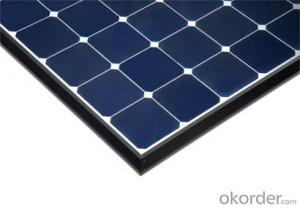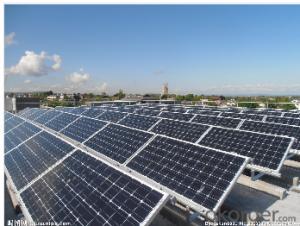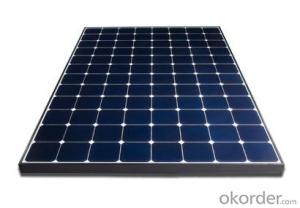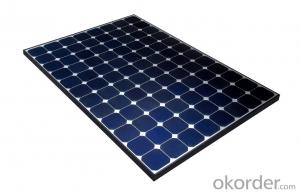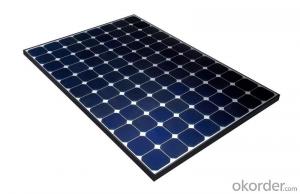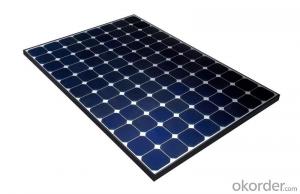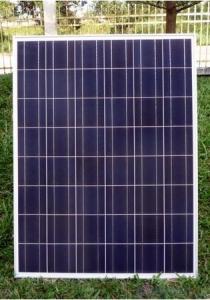CNBM Poly 400W Solar Panels with TUV UL CE Certificate for Residential
- Loading Port:
- Shanghai
- Payment Terms:
- TT OR LC
- Min Order Qty:
- 500 watt
- Supply Capability:
- 1000 watt/month
OKorder Service Pledge
OKorder Financial Service
You Might Also Like
Specification
CNBM Poly 230W Solar Panel with TUV UL CE Certificate For Residential
Introduction
Electrical connections are made in series to achieve a desired output voltage and/or in parallel to provide a desired current capability. The conducting wires that take the current off the modules may contain silver, copper or other non-magnetic conductive [transition metals]. The cells must be connected electrically to one another and to the rest of the system. Externally, popular terrestrial usage photovoltaic modules use MC3 (older) or MC4 connectors to facilitate easy weatherproof connections to the rest of the system.
Each module is rated by its DC output power under standard test conditions, and typically ranges from 100 to 365 watts. The efficiency of a module determines the area of a module given the same rated output – an 8% efficient 230 watt module will have twice the area of a 16% efficient 230 watt module. There are a few solar panels available that are exceeding 19% efficiency. A single solar module can produce only a limited amount of power; most installations contain multiple modules. A photovoltaic system typically includes a panel or an array of solar modules, a solar inverter, and sometimes a battery and/or solar tracker and interconnection wiring.
Micro-inverted solar panels are wired in parallel which produces more output than normal panels which are wired in series with the output of the series determined by the lowest performing panel (this is known as the "Christmas light effect"). Micro-inverters work independently so each panel contributes its maximum possible output given the available sunlight.[6
In contrast, a solar thermal collector supplies heat by absorbing sunlight, for the purpose of either direct heating or indirect electrical power generation from heat. A "photoelectrolytic cell" (photoelectrochemical cell), on the other hand, refers either to a type of photovoltaic cell (like that developed by Edmond Becquerel and modern dye-sensitized solar cells), or to a device that splits water directly into hydrogen and oxygen using only solar illumination.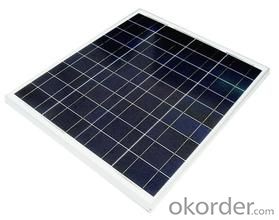
Suggested application
Home lighting business lighting,
Garden lighting, pavement lighting
Farmer household lighting
Decorative water pump
Traffic signal lighting
Industry area
Business area
Solar Power Plant
Product feature
Modules are made of Monocrystalline or Polycrystalline Silicon cell.
Materials and color of the solar panel frame: Clear anodized aluminum alloy type 6063T5 Universal frame; Silver-white color;
The output connection gathers the coupling: Selects conforms to the IEC-612615; 2005, class II, IEC61730 international standard; Airtight waterproofing binding clamp;
Module seal structure: The surface is thick, the high diaphanous rate armored glass with solar cell board special-purpose 3.2mm becomes after the high temperature lamination craft. The back selects has waterproof and anti- aged performance fine TPT materials. The entire block battery board has, the waterproofing, the anti- aging airtight and so on the fine performance;
Power tolerance: +/-3%
Packaging
International standard cartons (according to the requirements of customers)
- Q: Can solar panels be used in areas with high levels of dust storms?
- Yes, solar panels can be used in areas with high levels of dust storms. However, it is important to regularly clean and maintain the panels to ensure optimal performance. Dust storms may temporarily reduce the efficiency of solar panels, but with proper care and regular cleaning, they can continue to generate electricity effectively.
- Q: How do solar panels affect the electrical grid?
- Solar panels can have both positive and negative impacts on the electrical grid. On the positive side, solar panels help to reduce the demand for electricity from the grid, especially during peak hours when electricity is most expensive. This can lead to cost savings for the grid and reduce the need for additional power plants. Additionally, solar panels generate clean, renewable energy, which helps to reduce greenhouse gas emissions and combat climate change. However, the intermittent nature of solar power can pose challenges to grid stability and reliability. Fluctuations in solar energy production can create imbalances in supply and demand, requiring grid operators to carefully manage and integrate solar power into the system. Overall, solar panels can be a valuable addition to the electrical grid, but their integration requires careful planning and management.
- Q: I was wondering if they create other forms of energy besides electrical that is unwanted. Like heat due to the friction of something, or sound. Also why is a solar panel not able to collect 00% of the energy that is striking its panels. And how could the efficiency of this be hypothetically improved.
- Science. The best solar panels we have only get like 22% of the sunlight for conversion into energy. That is simply the best they know how to make with current technology. And for that your talking about a mobile panel that tracks the sun as it moves at the equator. A solar panel in say Canada is lucky to get 0% even on a sunny day. But even if a solar panel got 00% efficiency, it's still not a lot. Sunlight is too diffuse to be a good power source, and you'd need to cover lots of ground to get power. Worse, you can only get power when the sun is out during the day. So for power at night you'd need a battery, or another source of power. The 'newest' idea is to capture sunlight to make 'lasers' that boil water, to turn turbines and make electricity. They cost way more then they are worth right now though...
- Q: who has solar panels on their home and are they worth it
- They're only worth it if: # - you are rich enough to afford them over the long term. Commercially installed solar panels will take you over 0 years to see any financial benefit. #2 - you get the parts and some instructions and get them built yourself. DIY or get a local electrician to put them together. If you don't fit into any of these 2 categories, then they're NOT worth it.
- Q: 260 watt solar panels on an rv?
- There are many other controllers, you just need to get a sense for the limitations and make sure you are working within them. Controllers are not that hard to hook up, two connections simply go to the battery, plus and minus. Then the other two go to your panel. I like to put a switch at the panel output, leave it off while you are hooking up the panel side wiring of the controller, then when you are sure everything is connected properly, and you have some kind of battery power indicatioon at the controller, throw on the panel switch and see if it is charging. Remember that a panel is a power source, and connecting it to the controller while it is in the sun is like hooking up a car headlight while the lights are turned on. Another option is to wrap the panel in a blanket and put it in the shade while you are connecting it up. Your panel has a max amp rating, Imax, which will likely be around 5 or 6 amps at that voltage and wattage. Number 4 romex will work for that, as well as medium duty AC extension cord wire, if your run is less than 30 feet or so. Take care Steven, Rudydoo
- Q: all i want to do is provide enough electricity for 2 fluorescent bulbs i was looking at some 80 watt panels how many of those would i need and what else do i need for storing the electricity for use at nite? and how much would it all cost?
- The solar panels are made in China because there are fewer environmental regulations and cheap coal power. It takes a lot of energy to melt silicon and there are toxic waste products. It would be three to five times more expensive to make the panels in the US ( three times is just for reprocessing the toxic wastes ). Solar cell made in China are about $2 a watt, perhaps as low as $ a watt but in truth the claims for $ a watt or less solar panels as in thin film solar panels have much lower efficiency and require perhaps ten times more surface area.
- Q: Can solar panels be installed on a winery or vineyard?
- Yes, solar panels can be installed on a winery or vineyard. In fact, many wineries and vineyards around the world have embraced solar energy as a sustainable and cost-effective solution to power their operations. The vast open spaces available on these properties make them ideal for solar panel installations, which can generate clean and renewable electricity to meet the energy demands of the winery or vineyard. Additionally, solar panels can help wineries and vineyards reduce their carbon footprint and lower their energy costs in the long run.
- Q: i need to cut down on electricity bills, and so i was wondering if someone could give me step-by-step instructions, or websites that have step-by-step instructions on how to build an electricity generating solar panel.
- electric powered panels are actually not plausible for many persons. they are 2 great skinny layers of polarized cloth. while the solar hits them electrons pass from the st to the 2d layer with an quantity of stress. you are able to no longer reproduction that at abode. What you need to do is setup photograph voltaic heating panels and run them against a Stirling engine. this methodology is many times extra effective than time-honored electric powered panels besides in industry. they have warmth on one element and chilly on the different to generate stress. Hook that to any generator to offer electrical energy. in case you're useful construction a house gadget, weblog approximately it, others will desire to nicely known precisely the way you probably did it.
- Q: I need to have more information about what are solar panels. will you help me?
- Solar power is produced by collecting sunlight and converting it into electricity. This is done by using solar panels, which are large flat panels made up of many individual solar cells. Using solar panels is a great way to generate clean and renewable electricity to power equipment or even the average home
- Q: I don't see much solar panels on people's houses where I live. I got a long time to go before doing so but I was planning on buying a few solar panels when I retire in the far future. In your opinion, is such an investment worth it? Would you buy them? I realize they are very expensive hence why I said when I retire. Thanks for your opinion
- Regarding okorder /.. . In Hawaii, solar is going in like crazy, with long backlogs for installation. If it will be a long time until you retire, then there is no rush. The price of technology tends to go down with time, and in fact, solar panels today are less than half the price of what they cost us in 2006. Also, who knows where you'll be living when you retire? If it's Honolulu, the place may already have solar panels. In the woods of the Upper Peninsula of Michigan, it might never be worth it (but look into wind, there).
Send your message to us
CNBM Poly 400W Solar Panels with TUV UL CE Certificate for Residential
- Loading Port:
- Shanghai
- Payment Terms:
- TT OR LC
- Min Order Qty:
- 500 watt
- Supply Capability:
- 1000 watt/month
OKorder Service Pledge
OKorder Financial Service
Similar products
Hot products
Hot Searches
Related keywords
